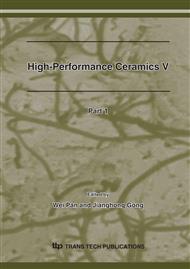p.1673
p.1677
p.1680
p.1683
p.1686
p.1689
p.1692
p.1695
p.1699
Flying Combustion Experiments and Numerical Simulation for Ti-B4C-C Agglomerated Particles during the Self-Reactive Spray Forming Process
Abstract:
With Ti-B4C-C as self-reactive spray forming system, the flying combustion process of the sprayed particles was studied by means of water-quenching experiments and numerical simulation. It was found that after the particles have been heated in the oxyacetylene flame for a short time, Ti in the particles melts first and then infiltrates B4C and C. The SHS reaction of the sprayed particles takes place subsequently. Then the liquid ceramic beads appear and crystallize into ceramic grains finally. By the ANSYS finite element analysis, it can be known that the SHS reaction of the sprayed particles starts after they have left the muzzle for about 9.5×10-4s and lasts about 1.45×10-3s before the ceramic beads solidify. The calculated optimal melting distance for the spray particles is about 116mm, which is consistent with the experimental results on the whole.
Info:
Periodical:
Pages:
1686-1688
Citation:
Online since:
February 2008
Authors:
Price:
Сopyright:
© 2008 Trans Tech Publications Ltd. All Rights Reserved
Share:
Citation:


